⚓ Our Navy in World War I: The U.S. Naval Campaign Against German U-Boats & Beyond
📌 Explore the heroic role of the U.S. Navy in World War I, from battles against German U-boats to convoy protection and naval expansion. This historical collection features official reports, naval engagements, photographs, and firsthand accounts that highlight the Navy’s contributions to Allied victory in WWI.
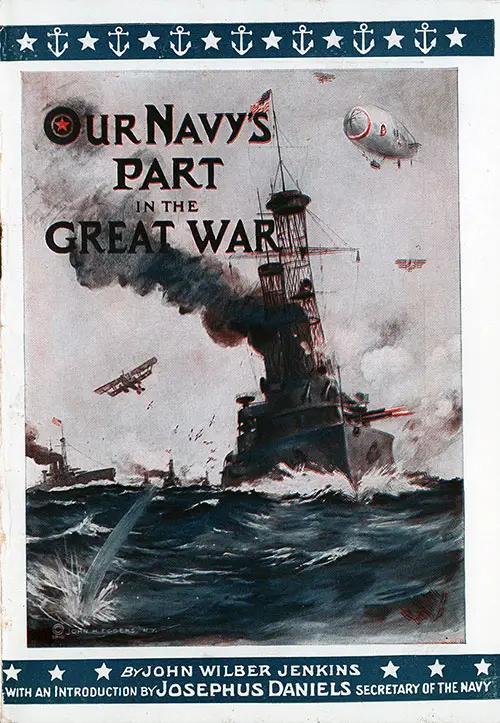
Front Cover, Our Navy's Part in the Great War by John Wilber Jenkins, 1919. | GGA Image ID # 184c84ca1d
⚓ Our Navy in the Great War
🔍 The United States Navy’s Pivotal Role in World War I
This comprehensive collection provides a detailed account of the U.S. Navy’s contributions to World War I, drawn from Our Navy's Part in the Great War by John Wilber Jenkins (1919). The page offers historical narratives, photographs, and first-hand accounts, illustrating the Navy’s rapid expansion, heroic battles, and technological innovations that helped secure victory for the Allies.
This section organizes the content based on the Booklet "Our Navy's Part in the Great War" by John Wilber Jenkins. It supplements the text with additional photographs to help tell the US Navy's story in World War 1.
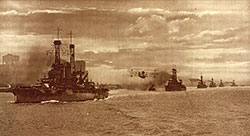
2,000 Vessels in Service When War Ended
The growth of the Navy in ships and personnel was phenomenal. When the war began, were 364 vessels on the naval list, of which 20 were listed as unserviceable for war purposes.
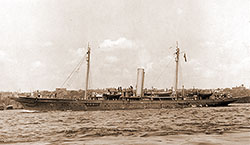
On November 5, the converted yacht Alcedo (SP 166), which had been on almost constant escort duty and had rescued 117 survivors of the Antilles when that vessel was torpedoed, was sunk by an enemy submarine while escorting a convoy from Quiberon.
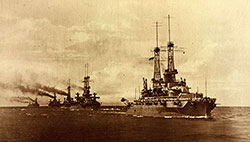
American Naval Fleet Sent Over There - 1919
Submarines had been successfully used by the British against enemy U-boats. In the autumn of 1917, American submarines were sent abroad to cooperate with the British forces.
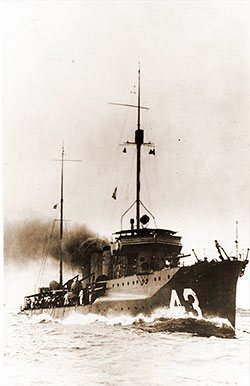
"Cassin," Hit by Torpedo, Saved by Quick Action - 1917
The USS Cassin was struck by a torpedo on 15 October 1917 but was taken to port and repaired. But one man was killed, Gunner's Mate Osmond K. Ingram, who gave his life to save the ship.
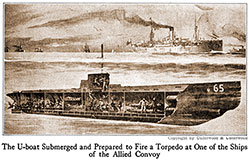
German U-Boats on American Coast - 1918
From the beginning, it was realized by the American naval authorities that Germany could at any time send her submarines across the Atlantic, and patrol vessels in home waters were constantly on the lookout for them.
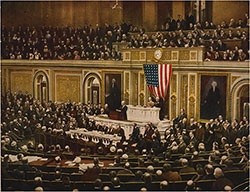
On April 6, 1917, the day President Wilson, per the resolution of Congress, declared the existence of a state of war with Germany, Secretary Daniels sent out the order for the mobilization of the Fleet.
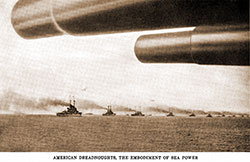
US Naval Fleet in the Great War
By January 1, 1918, there were 113 United States naval vessels across, and in October 1918, the total had reached 338 ships of all classes.
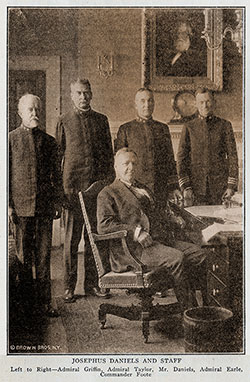
US Navy - Our First Line of Defense - 1919
The Navy was called upon to undertake many novel and untried tasks in the war. Still, whenever any new and challenging duty was imposed, the entire service responded enthusiastically, from admirals to apprentice seamen.
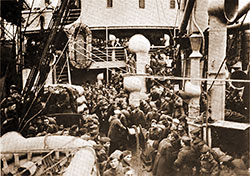
US Navy's Growth and Expansion During the Great War
The Naval Overseas Transportation Service, organized in January 1918 to carry supplies and munitions to the American forces abroad, grew in ten months to a fleet of 321 cargo-carrying ships aggregating 2,800,000 dead-weight tons.
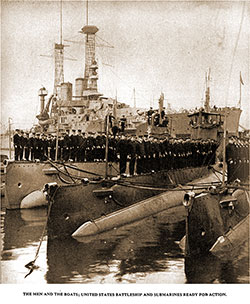
US Navy Ship Construction Program
Secretary Daniels announced in 1917 that the entire war-building program of the Navy embraced nearly a thousand ships. Most vessels authorized by the three-year program 1916 were contracted for early 1917.
🌟 Why This Page is Important:
✔ Chronicles the U.S. Navy’s transformation from peacetime operations to wartime dominance ⚓
✔ Features gripping stories of naval battles, convoy protection, and U-boat encounters 🚢
✔ Showcases rare historical photographs of naval engagements and personnel 📸
✔ Explains how the Navy played a crucial role in securing supply lines and protecting troops 🏅
✔ Reveals the technological advancements in shipbuilding and submarine warfare ⚙️
📌 Relevance to World War I:
🔹 The U.S. Navy was a critical force in countering German U-boats, ensuring safe passage for troops and supplies.
🔹 Naval expansion—from 364 vessels to over 2,000—demonstrates the scale of American commitment to the war.
🔹 Stories of individual heroism highlight the sacrifices and bravery of U.S. sailors during combat.
🔹 The Navy’s role in convoy protection and anti-submarine warfare was essential to Allied victory.
This page is a valuable resource for teachers, students, military historians, and genealogists researching World War I naval history, U.S. military expansion, and the evolution of naval warfare.
📜 Key Highlights & Most Engaging Content
🚢 2,000 Vessels in Service When War Ended
📌 The Navy’s astonishing growth—expanding from 364 ships to 2,000 by the war’s end—was critical to Allied success.
📌 The massive increase in naval personnel and shipbuilding enabled the U.S. to escort convoys, combat U-boats, and project naval power globally.
📌 Demonstrates America’s rapid wartime mobilization and how naval strategy shifted to meet the German U-boat threat.
📝 Why It’s Important:
🔹 Shows the Navy’s remarkable transformation in a short period.
🔹 Highlights the necessity of naval power in a global war.
🔹 Provides insight into how the U.S. emerged as a dominant naval force post-WWI.
⚔️ Alcedo Sunk by Torpedo – 1917
📌 The USS Alcedo, a converted yacht, was torpedoed while escorting a convoy, becoming the first U.S. warship lost in WWI.
📌 The ship had previously rescued 117 survivors of the Antilles before being struck by a German submarine (UC-71).
📌 Demonstrates the dangers of escort duty and the bravery of naval crews in protecting convoys.
📝 Why It’s Important:
🔹 Offers a gripping story of sacrifice and heroism at sea.
🔹 Illustrates the deadly efficiency of German U-boats.
🔹 Emphasizes the critical role of the Navy in defending supply lines.
🌊 German U-Boats on the American Coast – 1918
📌 The threat of German submarines reaching U.S. waters was a constant concern.
📌 The Navy maintained vigilant patrols along the East Coast to protect American shipping and prevent surprise attacks.
📌 American submarines were sent to Britain to assist in the anti-submarine campaign.
📝 Why It’s Important:
🔹 Highlights the strategic threat posed by German U-boats outside Europe.
🔹 Demonstrates how naval warfare extended beyond the Atlantic to the American homeland.
🔹 Explains why the Navy had to rapidly modernize its fleet and tactics.
🛡️ USS Cassin Torpedoed & Saved by Quick Action – 1917
📌 The USS Cassin was struck by a German torpedo but survived thanks to the bravery of its crew.
📌 Gunner’s Mate Osmond K. Ingram sacrificed himself to prevent further explosions, earning the Medal of Honor.
📌 The damaged ship was towed to port and later repaired, demonstrating the resilience of the U.S. Navy.
📝 Why It’s Important:
🔹 Showcases a heroic act of self-sacrifice in naval combat.
🔹 Demonstrates the effectiveness of damage control and quick response in saving lives.
🔹 Highlights the dangers U.S. naval forces faced while protecting Allied convoys.
🛳️ U.S. Naval Fleet in the Great War – 1918
📌 By January 1918, there were 113 U.S. naval vessels deployed overseas; by October, that number had grown to 338.
📌 The fleet was responsible for escorting thousands of Allied troop and supply ships across the Atlantic.
📌 The sheer size and strength of the U.S. Navy helped tip the balance of power at sea.
📝 Why It’s Important:
🔹 Illustrates the effectiveness of convoy systems in reducing losses to U-boats.
🔹 Shows how the U.S. Navy contributed directly to Allied victory.
🔹 Demonstrates the strategic shift in naval warfare during WWI.
📸 Noteworthy Images & Their Significance
📷 Greatest United States Naval Fleet Ever Assembled in American Waters
🔹 Illustrates the massive naval expansion that defined U.S. involvement in WWI.
📷 American Fleet in Atlantic Waters That Upheld Navy Traditions
🔹 Highlights the crucial role of convoy protection and anti-submarine warfare.
📷 President Wilson Reading to Congress His Famous War Message (April 2, 1917)
🔹 Symbolizes the moment the U.S. committed to war, with the Navy playing a frontline role.
📷 U-Boat U-65 Preparing to Fire a Torpedo at an Allied Convoy
🔹 Illustrates the deadly U-boat threat that the U.S. Navy was tasked with combating.
📷 Soldiers on Deck of the USS Madawaska Awaiting Their Turn to Go Ashore
🔹 Emphasizes the Navy’s role in safely transporting American troops to Europe.
📚 Relevance for Different Audiences
📌 🧑🏫 For Teachers & Students:
✔ Provides clear examples of naval warfare in WWI.
✔ Highlights technological advancements in shipbuilding and strategy.
✔ Shows how the U.S. Navy contributed to the war effort.
📌 ⚓ For Military Historians & Researchers:
✔ Documents key naval battles, strategies, and figures.
✔ Explains the expansion of the Navy and its impact on warfare.
✔ Explores primary sources and official reports from 1917-1919.
📌 🧬 For Genealogists & Family Historians:
✔ Useful for tracing ancestors who served in the U.S. Navy during WWI.
✔ Provides historical context for military service records.
✔ Explains the experience of sailors and officers during the war.
🌟 Final Thoughts: The Legacy of the U.S. Navy in WWI
⚓ The U.S. Navy’s role in WWI was transformative, shifting from a small fleet to a global force.
⚔️ Its battles, convoy missions, and anti-submarine efforts helped turn the tide against Germany.
🌍 This page provides an in-depth, richly illustrated look at how the Navy reshaped modern warfare, making it a must-read for anyone interested in naval history!
